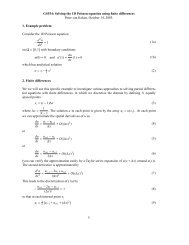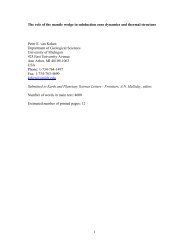Quantitative paleoenvironmental and paleoclimatic reconstruction ...
Quantitative paleoenvironmental and paleoclimatic reconstruction ...
Quantitative paleoenvironmental and paleoclimatic reconstruction ...
Create successful ePaper yourself
Turn your PDF publications into a flip-book with our unique Google optimized e-Paper software.
ARTICLE IN PRESS<br />
N.D. Sheldon, N.J. Tabor / Earth-Science Reviews xxx (2009) xxx–xxx<br />
3<br />
Fig. 1. Photos of representative paleosols. A) Painted Hills Unit, Eocene, Oregon. Dominated by Alfisol-like paleosols. B) Mascall Formation overlook, Miocene, Oregon. Near-mollic<br />
Inceptisol-like paleosols. C) Classic “red beds” from the Permian Cala del Vino Formation, Sardinia. D) Close-up of root mat carbonate rhizoliths, Renova Group, Montana.<br />
some future directions <strong>and</strong> some ways in which existing proxies may<br />
be extended. In general, no single proxy for weathering processes or<br />
past environmental conditions, or single type of quantitative data is<br />
without limitations. Therefore, a multi-proxy approach is key both to<br />
giving the investigator the widest possible range of information, but<br />
also to ensure reproducibility of her/his results. Thus, the approach<br />
Fig. 2. Comparison between modern soil <strong>and</strong> paleosol equivalent. A) Modern xeric Mollisol, southwestern Montana; B) late Miocene xeric Mollisol, central Oregon.<br />
Please cite this article as: Sheldon, N.D., Tabor, N.J., <strong>Quantitative</strong> <strong>paleoenvironmental</strong> <strong>and</strong> <strong>paleoclimatic</strong> <strong>reconstruction</strong> using paleosols, Earth-<br />
Science Reviews (2009), doi:10.1016/j.earscirev.2009.03.004















